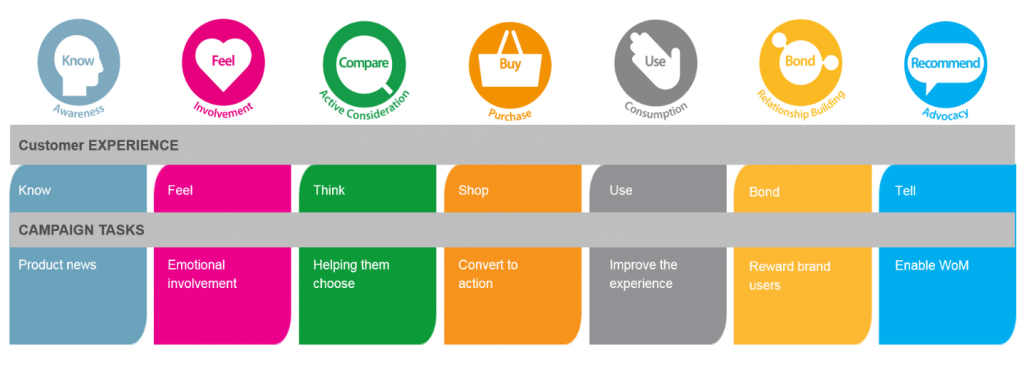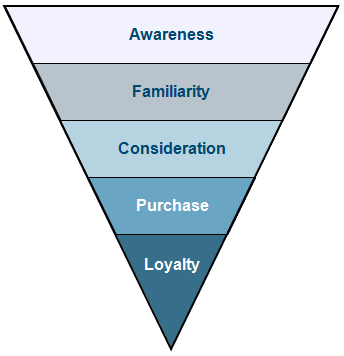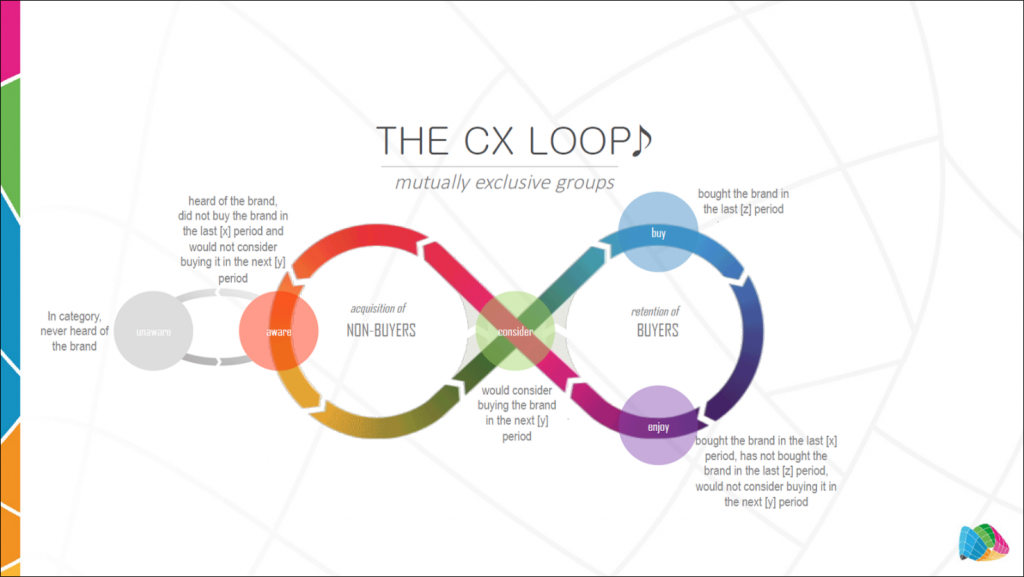Publicis Media News The changing customer journey
From linear to non-linear models
Understanding how consumers make their purchasing decisions and which touch points they come into contact with along the way is considered to be a key factor for success in today's marketing world. "Customer journey" is the catch phrase of the hour. Of course this isn't really news to anyone. However, the customer journey has changed a lot over the last few decades as the world has become digital. The models used to describe the customer journey have changed as well.
The original model of the customer journey was the AIDA model. This model was described by Elmo Lewis as early as 1897 and until recently was more or less the basis for all conventional customer journey models. From a sales and marketing perspective, the AIDA model describes the journey to buying a product as four universally familiar steps (see Fig. 1):

Fig. 1: The AIDA model
Subsequent models were largely developed on the basis of this approach. One of the reasons for developing new models was the understanding that the relationship between a brand and the consumer doesn't end with the purchase of the product. On the contrary, this is where the relationship really begins. Since 2004, ZenithOptimedia has been using the consumer pathway approach, which describes the customer journey in seven steps: "Awareness", "Involvement", "Active Consideration", "Purchase", "Consumption", "Relationship Building" and "Advocacy". The first four steps correspond more or less to the AIDA model. The last three steps describe a CRM process which takes place after the purchase and which is focussed not just on repeat purchases but primarily on the product being recommended by the customer. This model was used analytically in order to define the communication "focus of effort" and in order to select the touch points that are appropriate for this focus of effort. Paid and owned media tend to be used during the period before the act of purchase, while the focus after that shifts more to owned and earned media (see Fig. 2).

Fig. 2: The ZenithOptimedia consumer pathway model
Funnel models have become a very common marketing feature. They are typically guided by the degree of loyalty to brands and are frequently modelled as funnels (hence the name) and sometimes also as pyramids. The advantage of funnel models is that one can see at a glance how the business potential of a brand can be utilised. "Purchase" and "Loyalty" at the bottom of the funnel only come into play if all the other levels such as “Awareness”, “Consideration” or “Relevant Set” are wide enough (see Fig. 3). If, for example, there is high awareness but too many non-buyers who never reach the "Consideration" stage, this leads to a bottleneck. The effect of this shortage extends to the bottom of the funnel, where sales are correspondingly weak. One approach in this case, for example, would be to target non-buyers in order to have an opportunity to make full use of the brand's potential.

Fig. 3: Sample brand marketing funnel
All of these models have one thing in common: They often look very linear on paper – and are often interpreted this way as well. A linear structure suggests that each step follows logically from the preceding one, and there is no way back in this logic. No model is a perfect representation of reality, and this is not the purpose of a model anyway. A model is intended to simplify reality and reduce it to the essential. It should be a tool which can help perform the relevant analyses that lead to the right decisions. Thus the goal is not to create a perfect reflection of reality, but rather to reduce complexity. This reduction isn't a problem as long as the model is able to describe the relevant aspects of reality. Linear customer journey models, however, have certain shortcomings which are quite problematic.
A linear model doesn't show lost customers, for example. Someone who has used a brand in the past but has stopped doing so (perhaps for a good reason) is simply downgraded in a linear model and assigned to the same category as a naive new customer. But one would have to communicate differently with this customer than with someone who hasn't had any product experience. Yet this important difference is lost due to the simplification of a linear step model. One would certainly fail to win back a frustrated former customer with a product sample. This is a significant shortcoming of linear models, especially in times of tough competition for market share.
The defined end point of a linear model is another problem. Regardless of which step one defines as the end of a linear customer journey, it will always be inadequate since the actual journey is never over. There is always some continuation after the purchase and a recommendation. After the purchase is also always before the next purchase. And even a customer who is assumed to be highly loyal can get angry about something and turn to a different brand.
The only solution to this problem is to consider the customer journey using a non-linear model, as a journey without end. ZenithOptimedia has developed such a non-linear model, the CX Loop, which replaces the linear approach as the basis on which analyses are performed. The CX Loop is based on three connected brand experience loops (see Fig. 4).

Fig. 4: The CX-Loop by ZenithOptimedia
The first loop describes the state between "Non Awareness" and "Awareness". The purpose of communication here is to anchor the brand in the consumer's awareness. The point at which the consumer is finally aware of the brand - and doesn't forget it again right away - is the entry point to the next loop, which describes the state between "Awareness" and "Consideration". The purpose of marketing here is to make the brand as interesting and relevant as possible to the consumer, so that they take it into consideration for their next purchase in this product category. Once this state has been reached, the consumer is in the third loop – the state between "Consideration" and "Buy". Naturally, the purpose here is to motivate the customer to make the purchase. The process doesn't end with the purchase but keeps going: The product is used – this stage of the third loop is optimistically called "Enjoy". The consumer uses the product, hopefully with so much enjoyment that it is purchased again when the "Consideration" step is reached once more during the next purchasing cycle. But it is also possible for the consumer to choose a different product. In this case, the consumer journey from the brand's perspective leads back to the Awareness / Consideration loop. The brand has to make another attempt from here, but a decline into the irrelevance of being forgotten is also conceivable. The journey can go from any point in the CX Loop to any other point. And this is why the CX Loop is superior to linear models. It is much better than all previous models at capturing the ongoing dynamics of the customer journey, making it an effective tool for deciding on the right strategic measures.